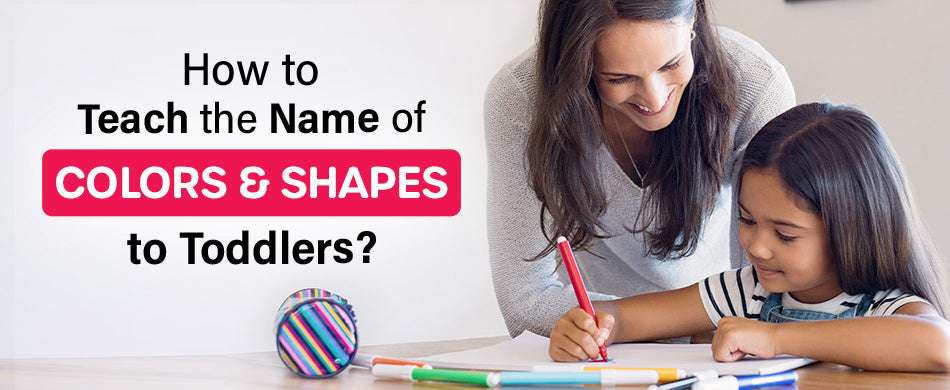How to Teach the Name of Colors and Shapes to Toddlers?
- by Baby Organo

Are you wondering if it is the right time to introduce core skills to your toddler? In this era where technology rules and children are primarily exposed to screen time, inculcating basic learning skills, and preparing your kids for school is a challenge every parent faces.
Your child will have different learning capabilities and understanding; homeschooling instils a sense of confidence in your little one.
What are Core Skills: Why Should Your Child Learn Them?
Core skills are essential and mandatory skills that toddlers should know before they step into a formal learning environment. It creates a solid base and foundation for future learning by developing these critical skills. The skills are classified as:
| Skill Category | Benchmarks |
| Gross Motor | Walking, Running, Jumping, Climbing |
| Fine Motor | Drawing Feeding, Clapping |
| Social | Role-play, Group-play |
| Sensory | Tasting, Smelling, Hearing |
| Cognitive | Problem-solving, picture interpretation and processing |
Thus, learning colours and shapes is a part of cognitive skills that helps them recognize objects, co-relate, and develop language later. The best example is an association with traffic lights. A child understands road signs and develops spatial awareness through differentiation between colours.
Benefits Your Child will have After Learning Shapes and Colors
When you introduce colours and shapes, the toddler acquires new words to his vocabulary and tries to organize objects, sort and draw connections. Your child’s brain processes information whenever you tell him a new colour and its associated things.
A child who develops the core skills earlier has a better understanding and academic performance later in life. So, let us learn some ways to introduce our little explorers to the magical world of shapes and colours because, as parents, we are aware of our kid's knowledge.
Let Us Learn the Tricks
Majority of children enjoy exploring and learning colours and shapes. However, picking up simple yet engaging activities can make the process more interesting.
1) Finger Painting
You will need any two primary colours and a piece of paper.
- Start with two colours at a time since it will let your child understand the concept clearly. Let your child dip his finger in the colour and paint a picture.
- Once you are done with the primary colours, take it a step up by mixing two colours and letting your child witness the result.
- Ask your child questions about the colours he is using and which one he loves the most.
- Further, ask your child to find things around him of the same colour as he is using.
2) Colourful Toys
Use your child's favourite toys for guiding about shapes and colours since the little one is already attached to them. Choose one toy at a time and talk about the colour and shape.
You can ask the child to point at toys of particular colour or shape and repeat it several times. Once you think he knows the shapes and colours appropriately, change the toys and begin the activity again.
3) Similar Entities of Different Colours
You can perform this activity with blocks, crayons, fruits or items used in daily life. For example, tell your child about green and red apples so that he knows you are talking about the colour and not the object.
Ensure you keep it engaging, as this may be difficult for young toddlers. Choose a different item every time and go steadily. Do not try to make your child perfect at once.
4) Explore through a Walk into the Nature
Give your child new learning opportunities, and one such way is to go for a nature walk and let your kid explore different colour variations around him. Introduce the surroundings and let the thinker observe shapes formed by buildings, cars and other structures.
Your kid will be fascinated to learn new things and understand that one colour can have different shades. For example, a green leaf can be of different shades, and so is the sky.
5) Choose the Right Books
Reading is a great habit every parent should teach their child from an early age. Search for books about shapes and colours and read them to your kid. Reading out to your little learner strengthens the bond and gives a better insight into shapes and colours.
You could even pick a colourful storybook and ask questions about different colours he can see. For example, focus on the colours of characters like brown bear, white bunny, etc.
6) Organize an in-house Treasure Hunt for Colourful Objects.
Unravel your child’s investigator skills with the treasure hunt. Sit in a room and ask your toddler to bring an object of a particular colour from any other room. Let him hunt around and get the item to you. You could give a reward if the child successfully completes all the tasks.
If your kiddo is an expert in this now, you can complicate it by associating a shape with the colour or specifying a particular room where the child needs to bring the object. To make it more interesting, take turns and let your kid be the instructor as well.
7) Sing Songs about Colors
There are several songs about colours which can help you teach the concept to the little scholar without any screen time. Your child will eventually learn the songs when you play them a few times.
8) Teach Basic Shapes First
You may want your child to learn shapes around him but remember most forms will be three-dimensional, which might confuse the kid later. Thus, initially, introduce two-dimensional shapes like triangles, circles, or squares.
Once you are confident enough, he can associate shapes well and move to complex ones like pentagons and octagons.
9) Let Your Child Trace 3D Objects on Paper.
Use 3D items and let your child trace its outline on a piece of paper. This will render a two-dimensional figure that will help your child relate to the difference in the object’s shape and outline.
10) Create Fascinating Shapes and Figures with the Regular Toy Blocks
Blocks are an innovative and engaging method to teach shapes by building figures of their choice. You can then ask them which shapes they used to make the figure. Also, we can talk about different colours being used.
11) Make Your Kid Explore Sorting Method
Sorting is a widely used teaching method in schools as it familiarises your child with colours and shapes with ease. For example, you can mix two different types of beans and ask your kid to sort the two into separate bowls based on colour.
12) Make Your Child Learn Playdough
Playdough is the best way to let your little one be creative while you teach him important lessons. Sit with different coloured dough, ask your child to pick a particular colour, and then make one shape. Your child might take time to excel in this, but it is worth the time and effort.
13) Teach Them To Play Shape Peg Puzzles
Shape puzzles have become very popular recently because they let parents teach the skills with the least effort. A puzzle comes with cut-outs and corresponding shapes. The little scholar must fix the form in the right place to complete it.
14) Let Your Child Explore Flashcards
Flashcards are a visual teaching tool you can introduce at an early age. You can make your own set of flashcards for colours and shapes according to your child’s knowledge and upgrade it as he moves forward.
Be Patient and Calm With the Teaching Activities
Now that you know all the best tricks to teach colours and shapes to your toddler, you may be excited and want to start with all of them at once. But patience is the key. Do not take up all the listed activities at once. Use one at once and keep shuffling to ensure your kid is not bored.
Understand that the kid is still young and needs time to process all the information you throw at him. Therefore, do not get disappointed if he or her does not perform as per your expectations.
Give him time and practice. If you feel the baby is not interested in one activity, switching to other learning tools is better than forcing him to attain perfection.
Let the young minds flourish at their own pace. You should only render a supportive development tool which engages them. You will attain the results over time as your child develops confidence.
Conclusion: The Key Takeaways
Developing core skills at an early age is crucial to prepare your little champions for the upcoming challenges in academics and real life, where they would need to apply concepts practically.
Therefore, you should start homeschooling your toddler and focus on developing basic problem-solving abilities and colour and shape recognition.
Try keeping it simple initially and gradually increase the difficulty level to induce independent thinking. So, try the tricks and have fun learning that both of you will enjoy.
- Posted in:
- Parenting tips





